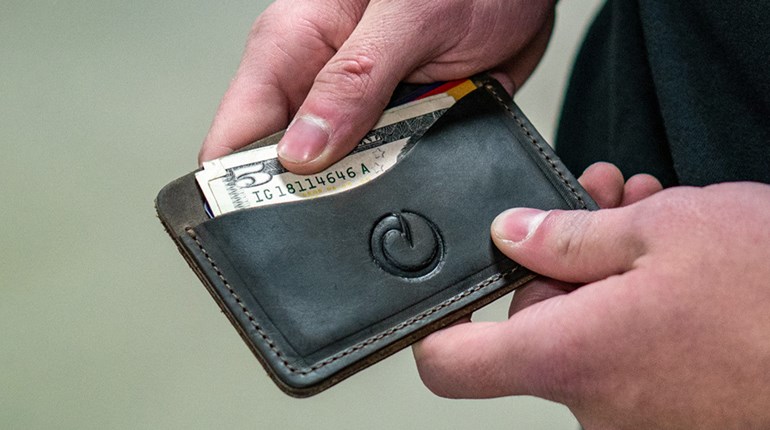
The big-bore 1911 (right) remains a solid choice that continues to evolve, but the author’s particular training and experience have led her down the path of the medium-caliber, MRDS-equipped, striker-fired pistol.
The other day I was rearranging some old cardboard boxes full of accessories, sorting them into stackable plastic storage totes so they’d be easier to find later. In one of those boxes, I ran across a bunch of stuff from an earlier period in my handgun-carrying life, back when I first decided to get serious about the practice of going armed.
Embarrassing confession time: I’d owned guns for more than 15 years and worked in gun shops for a decade before I got really serious about carrying a dedicated, fighting handgun all the time. Prior to the decision I made in 2003 to practice what I preached, I carried a holstered pistol at work and maybe on my belt or in the glovebox if I was “going somewhere I thought I might need one” (the wisdom of going someplace where you think you might need a gun is a topic for a whole ’nother column). Other than that, I just threw a little something—like a Beretta Jetfire or a Colt Detective Special—in my purse or coat pocket like a lot of folks do.
So, it was in 2003 when I got serious about carrying a gun all the time, from clothes-on in the morning until clothes-off at bedtime. Since my goal was to be serious about this, I modeled the behavior of things I’d read in gun magazines, as well as the mentors I consulted at the time.
What I’d learned from all those books and magazines and mentors was that the ne plus ultra of a serious carry setup was a 1911-pattern pistol in .45 ACP, with a specific set of features, carefully vetted for reliability and accuracy. The serious gun-toter would carry this pistol in a leather inside-the-waistband holster, from one of a small handful of makers, on a properly-sized leather gun belt, on or slightly behind the strong side hip. This, then, was the gear of the serious pistol carrier. So, let it be written, so let it be done.
I had the pistol already, a Springfield Armory Professional model from the company’s Custom Shop, which was arguably as reliable and accurate a 1911 as could be had straight out of the box. I loaded it up with 230-grain Remington Golden Saber jacketed hollowpoints, just like the FBI specified for the Professional models the Bureau issued. The whole thing went in a Galco Royal Guard holster on a Milt Sparks belt. Combined with regular practice, I felt pretty well set up.
The first change in my path was more one of attitude than equipment. The more I conversed with various experts in terminal ballistics, the more I was coaxed around to the viewpoint that, given quality, modern JHP ammo, there isn’t much difference in effectiveness between the service-caliber handgun rounds. Oh, sure, I was still carrying a .45 ACP, but by then it was mostly because that’s the round the 1911 was originally developed around.
The next change came from two sources. One was listening to the well-known instructor Tom Givens explain why he’d gone from a 1911 to (at the time) a Glock G35. He talked about the increase in frequency of incidents with multiple attackers, and described the 1911, with its 7+1 or 8+1 capacity as essentially a “two-bad-guy gun.”
The other source was a more pragmatic one from personal experience: I was attending more training classes and discovered that not only was burning up 500 or 1,000 rounds of .45 ACP expensive, but I was changing magazines about twice as often as the students shooting double-stack nines.
So, reluctantly, the Springfield Professional ultimately got retired in favor of a plain-vanilla Smith & Wesson M&P9. Surprisingly, not only did I not get killed on the streets, but my shooting with my carry gun continued to improve, since I could afford to do a lot more of it.
It was about this time I was persuaded that Kydex was an OK material for a holster. I went from a confirmed leather snob to regularly carrying a Dark Star Gear Kydex holster. Don’t get me wrong, I still love a leather holster and both kinds have their advantages: Subjected to heavy usage, I believe a well-made horsehide holster like one from Milt Sparks will probably be more durable than even a good Kydex one, while I think the Kydex rig will offer cleaner and more uniform draws. I know my draw gained in both speed and consistency when I switched, at any rate.
Probably the last change was overcoming the resistance to anything battery-operated on a carry pistol. When I started carrying the aforementioned M&P, the late Todd Louis Green suggested I add a Crimson Trace Lasergrip to it. Seeing me balk, he pointed out that, since it replaced the factory backstrap on the gun, it didn’t add any appreciable weight or bulk and didn’t affect holster fit, so why not put one on there?
I gave in and didn’t regret it. For the next several years I carried that M&P with both a Lasergrip and a Lightguard on it. In low-light classes and matches, both the laser and the light came in handy, and at no appreciable penalty to the ease of carrying the gun itself, thanks to that well-designed holster from Dark Star Gear. It’s not hard to see the line connecting that M&P9 setup 10 years ago to the FN 509 Compact with the Trijicon SRO and Streamlight TLR-7 I’m carrying these days.
Sorting out my old accessory boxes, handling that old, well-worn Royal Guard holster and the double- magazine carrier for the single-stack 1911 magazines brought back a lot of memories. I learned a lot while I was carrying that holster, and I hope I continue learning with the gear I’m using now.





































